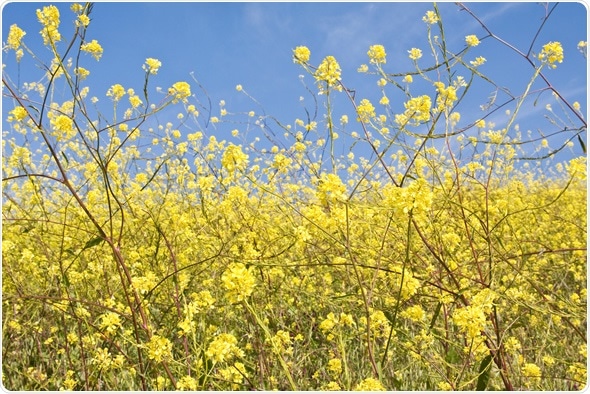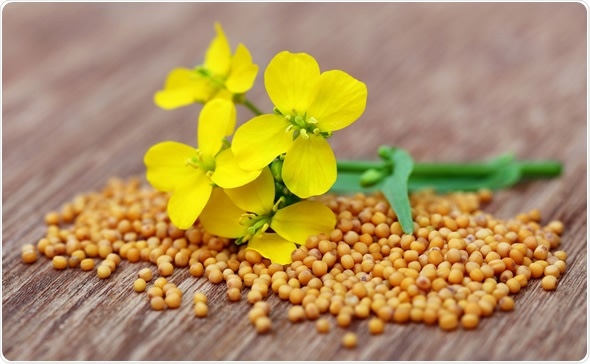
Mustard Allergy
Food allergy is an immune response triggered by mistaken immune reactions to harmless proteins in food which are structurally similar (homologous) to allergens. It occurs more frequently in people who have other allergic tendencies, such as atopic dermatitis.
IgE is an antibody that reacts with the food protein and initiates a cascade of chemical reactions, resulting in an allergic reaction. One of these chemicals is histamine, which is responsible for the dilation of small blood vessels, causing redness and swelling of the skin; itching; and increased secretion from the nasal mucosa, resulting in a runny nose and burning or itching. While most food allergies produce localized reactions, in some cases, the reaction gets out of hand and precipitates a body-wide release of potent chemicals triggering an anaphylactic reaction, characterized by a steep fall in the blood pressure, wheezing, and many other symptoms.
All food allergies are not IgE-mediated. Some are caused by other immune cells, and is confined to the skin, resulting in eczema, and / or the gastrointestinal system, producing heartburn and indigestion. This type of food allergy may produce diarrhea and acid reflux even in small babies.
Mustard allergy is the most common among the spice allergies.

Wild mustard plants growing in central California - Image Copyright: David M. Schrader / Shutterstock
Sources of Mustard
Mustard is found in many foods, including baby food, spices, sauces, salad dressings, vegetable pickles, processed meats and soups. There are many varieties of mustard including:
- Black mustard (Brassica nigra)
- Brown (or Oriental) mustard (Brassica juncea)
- Yellow mustard (Guillenia flavescens)
- Oriental mustard (Brassica juncea).
Mustard powder contains a mixture of yellow and Oriental mustard. The major allergen in yellow mustard is Sin a 1, while that in Oriental mustard is Bra j 1. Sin a 1 resists enzymatic digestion and heating. Babies may be sensitized via breastfeeding and in utero.

Mustard flowers (Guillenia flavescens) with seeds - Image Copyright: Swapan Photography / Shuterstock
Symptoms of Mustard Allergy
Mustard allergy usually starts before the age of three years. Mustard allergy may often produce severe symptoms during the very first episode and involve the skin, the gastrointestinal tract, or anaphylaxis. Since the latter may endanger life, labeling of foods which have mustard as an ingredient is mandatory.
Symptoms may develop within an hour of eating food containing mustard, and include:
- Skin reactions such as eczema, rashes, urticaria, or pruritus
- Swelling of the lips, face, tongue, and throat
- Swelling of other parts of the body
- Conjunctivitis
- Palpebral edema
- Wheezing
- Runny nose and sneezing
- Breathing difficulty
- Abdominal pain, diarrhea, nausea or vomiting
- Diarrhea and acid reflux in babies
- Dizziness
- Anaphylaxis
- a more severe form of allergic symptoms, or
- life-threatening symptoms such as swelling sufficient to obstruct breathing, shock, a fast and irregular pulse, and loss of consciousness
Risk Factors
If you or an immediate family member had a history of any allergic condition, you have a somewhat higher risk for a food allergy. All members may not manifest the same allergy.
Diagnosis and Treatment
Mustard allergy is diagnosed from the clinical history followed by skin prick testing and specific IgE estimation. Since it cannot be cured, the focus is on the prevention of dangerous recurrences. Mustard must be completely avoided. If severe allergic reactions occur, the patient must carry self-injectable epinephrine for emergency use as soon as symptoms appear. The patient must be hospitalized immediately afterwards for further treatment or observation. Local treatment for skin rashes includes the use of emollients, topical corticosteroids, and antihistamines to suppress inflammation and to reduce allergic manifestations.
References
- http://www.nhs.uk/Conditions/food-allergy/Pages/Causes.aspx
- http://farrp.unl.edu/informallseeds
- http://www.fda.gov/ForConsumers/ConsumerUpdates/ucm089307.htm
- http://www.food.gov.uk/sites/default/files/top-allergy-types.pdf
- http://www.ncbi.nlm.nih.gov/pmc/articles/PMC3362728/
- https://www.researchgate.net/profile/Guy_Dutau/publication/227896402_Mustard_allergy_in_children/links/542557e40cf238c6ea740212.pdf
- http://plants.usda.gov/java/ClassificationServlet?source=continue&sort=sciname
- https://www.researchgate.net/profile/Gisele_Kanny/publication/10792616_Prospective_study_of_mustard_allergy_First_study_with_double-blind_placebo-controlled_food_challenge_trials_(24_cases)/links/542071020cf203f155c59673.pdf
Further Reading
Last Updated: Aug 23, 2018























.png)









No hay comentarios:
Publicar un comentario